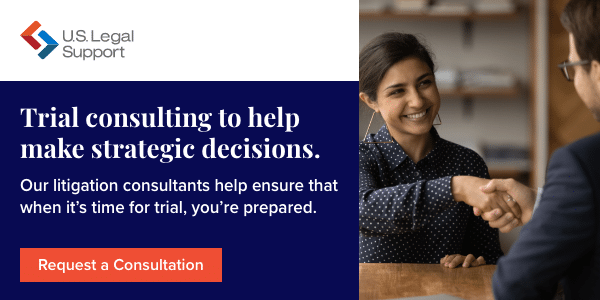

Trial attorneys often invest in their presentation game—eliminating ticks, getting over public speaking nerves, and dressing to hit the just-right level of professionalism. Presentation, after all, is key to not only holding your audience’s attention but swaying them to your argument.
A quick way to lose points, however, is fumbling exhibits. Technical glitches, objections, delays—regardless of how human it is; any error will be what jurors remember the most.
Effective preparation means understanding how to prepare exhibits for court and how to introduce exhibits at trial in addition to all the intricacies of your case.
Although the “65% of people are visual learners” statement isn’t grounded in scientific research, we all know that comprehension and retention take more than sitting still and listening to a speaker for hours on end. 1 The more senses you can draw on to bring your story to life, the more you’ll engage your audience.
Visual exhibits are particularly critical at trial to help jurors:

By the end of a case, you may have multiple sets of evidentiary identifiers. Long before you settle on a final exhibits list, you’ll want to electronically and physically tag anything of interest during discovery to track via software or a spreadsheet.
As soon as you begin to gather evidence—or potential evidence—keep exhibits in mind. Evidence is categorized in multiple ways, but the most basic is the division of real vs. demonstrative.
During the discovery process, as you pore through court documents, analyze data, and interview potential witnesses, don’t just look for direct evidence to build your case on. Consider and tag items that may be compelling or convincing as part of an exhibit.
At this stage, through to the final exhibits list, apply consistent, clearly formatted, and easy-to-decipher naming and documentation protocols. Any team member should be able to easily scan and comprehend how information is classified, labeled, and summarized.
Use a spreadsheet or dedicated software that allows you to easily search, filter, and group information throughout trial preparation.
Check with your state’s guidelines on preparing exhibits for court before you invest time organizing them. At the trial stage, you may need to:
For court, stickers or labels will display exhibit identification that’s simpler than what you use internally during discovery. Exhibits from the plaintiff are typically labeled numerically as Exhibit 1, Exhibit 2, and so forth, while defense exhibits are coded by letter: Exhibit A, Exhibit B, etc. 2
However, exhibits aren’t always introduced in the order originally planned on your exhibits list. If your court guidelines stick with the actual order of introduction during trial, then include a sticker on each trial exhibit with “Exhibit ___” on it that can easily be filled out in court. 3
The most stunning and convincing exhibit may not make it in front of a jury. There are a few stages to the life and use of both real and demonstrative evidence: 2
State guidelines vary slightly but tend to follow the Federal Rules of Evidence (FRE). Under Rule 402, the FRE states that “relevant evidence is admissible” unless it’s an exception by the Constitution, statute, or further clarifying court rules. 4
The exceptions to relevance mean that evidence is not admissible if it is:
Exhibits are often considered at pre-trial motions or in hearings outside of the jury’s presence to determine whether they’re compliant with the FRE or state court rules. Filing motions in limine, particularly for demonstrative evidence, can help prevent objections and delays, and provide time to make changes to overcome inadmissibility. 3
In addition to arguing the relevance of an exhibit—and that its relevance is not overruled by the exceptions noted above—most types of exhibits in court may need to prove:
Once the administration and qualification of exhibits are checked off, it’s time to focus on how and when to introduce them to the jury—and how to adapt if change is required. You may need to alter exhibit content, sequence, or delivery based on:
Use a binder with sections that can be swapped around easily, and include copies of both physical and digital exhibits in your binder for reference and adaptation. However, it’s important to note that digital presentations are much more common now, and it may be worth consulting a trial services partner to help.
Also, in addition to the originals that will be submitted into evidence, bring physical copies:
Separate from the initial evidence list and the exhibits list submitted to the court, set up a list of exhibits that will (or may) be used at trial. It should include information pertinent to supporting stages of your argument, such as:
Simply reading through this list, complete with the relevance notation, should provide the outline of the story that your arguments will tell. The order is connected to how elements of the type of evidence, like physical evidence, connect narratively in the way that best proves your case.
Also, consider timing in terms of:
There’s no quick tip that takes the place of practice. Do a full run-through with all exhibits and consider how to:
In addition to practice, consider:
Before you present your exhibits to the court, make sure they can pull their weight. TrialQuest transforms complex information into graphics and demonstrative exhibits that educate jurors, enhance their retention of key facts, and illuminate your case arguments.
Their team of professionals includes professional designers who have specific experience in illustrating, animating, and crafting presentations not just for the legal industry but for specific practice areas. From medical to maritime, we can deliver presentations that help you win cases.
TrialQuest offers decades of experience providing top-notch consulting and support services to attorneys and firms of all practice sizes and types.
Our combined teams have supported over 20,000 high-risk trials, arbitrations, and mediations in nationwide jurisdictions. We provide trial graphics, exhibits, and demonstratives, trial presentation and technology services, jury research and consulting, mock trials, and witness preparation.
In addition to litigation consulting and trial services, U.S. Legal Support supports attorneys with multi-methodology court reporting, realtime transcription, interpreting and translation services, record retrieval, analysis, and organization, and more
Ready to learn more? Visit our trial services page for further details or to connect with us directly.
Sources:

Julie Feller is the Vice President of Marketing at U.S. Legal Support where she leads innovative marketing initiatives. With a proven track record in the legal industry, Juie previously served at Abacus Data Systems (now Caret Legal) where she played a pivotal role in providing cutting-edge technology platforms and services to legal professionals nationwide.
![]()
Content published on the U.S. Legal Support blog is reviewed by professionals in the legal and litigation support services field to help ensure accurate information. The information provided in this blog is for informational purposes only and should not be construed as legal advice for attorneys or clients.